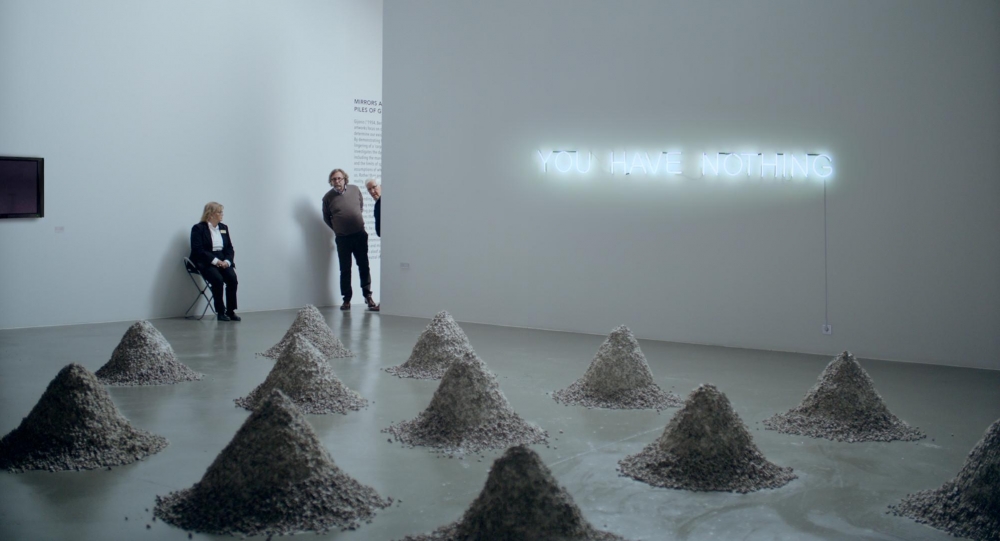Swedish film director Ruben Östlund’s The Square, which this year received the Palme d’Or at Cannes and was also screened at the Golden Apricot Yerevan International Film Festival, is essentially a provocative satire that circles around human and humanistic ideas, media tricks, and contemporary art.
All these turns are ingeniously connected with the idea of a square, which is not only a public place, but also an art installation, a screen opened on YouTube, and an enclosed geometric illusion. In short, it is an allegory that is happy and worrying at the same time.
The main character is Stockholm Modern Art Museum curator Christian, who wears beautiful suits and drives an eco-friendly Tesla car, has two daughters and is a very patient father, likes his museum and tries to find ways to present modern art in the modern digital environment.
Right at the start of the film, his mobile phone and wallet are stolen in a crowded square. No big deal about the wallet; what’s important is hiw phone, which is the entire world for people today.
Constructed around a phone was another film of Östlund’s, Force Majeure, in which the main character in an avalanche saves his iPhone first — not his wife or children. It happens so instinctively that there’s no time left even to experience a dilemma.
The Square is a surrealist episode of people and their environment today, presented in sometimes subtle, sometimes rude humor. But in all cases it is a film where the modern European (prosperous, attractive, educated, without [psychological] complexes, media professional submerged in the environment) is trying to feel a part of society. And not only to feel, but really to be.
This is the desire or motivation that often becomes a topic of contemporary art and then as a provocation and intervention forces the audience to become a direct participant in the work of art, and not just the viewer or enjoyer.
For Östlund, modern conformity and the media (and art as media) are opportunities for inspection and mockery.
Christian undertakes an art installation called “The Square,” isolating a small and very specific space where anyone can enter and do something for the public good — even accept that in that space he is obliged to respect others and is ready to take care of them.
For instance, to show that he trusts his surroundings, leaving his phone and wallet thrown on the floor in the square…
The enclosed humanistic space actually isn’t replenished. It remains an artificially outlined empty surface.
To promote this project, the museum contacts independent PR professionals, who upload a promotional clip on YouTube that gets an enormous amount of views.
As per the rules of the internet, the main character of the video is a young girl (definitely blonde) holding a cat (a trendy animal that ensures views). The girl enters the square and explodes, together with the cat. As a result, thousands of people become interested in the museum, and the museum is forced to call a press conference and provide an explanation for the ethical violation it allowed.
Real life itself, it seems, is an art installation, a total show, where all are proportionate and chained by one another’s decisions. When, for example, Christian, thanks to an app, finds the location of his phone, he places in the mailboxes of all of the building’s residents a letter that reads “I know you stole my phone.” The result of that letter is disastrous…
Every scene in this film imbued with humor is structured like an anecdote.
The intellectual conversation about art is interrupted by frequent swearing; the curator is unable to explain to the journalist the meaning of the text he himself wrote.
The cleaner unknowingly vacuums one of the museum’s sand displays, and the employees are forced to bring a new heap of sand from outside and complete the concept.
The American journalist and Christian’s love adventure is so theatrical and nerve-wracking (people argue while an installation is being assembled on the adjacent wall) that it stops being both love and adventure. It becomes a burden.
Of course the most impressive scene is the official dinner banquet, when the elite in evening wear and eating with crystal tableware participates in the man-ape performance (this is a direct reference to Oleg Kulik’s famous dog-man action in the 1990s, in which the creator himself was the object on display and the chaos maker). The beautifully dressed and adorned Swedes attack the man-ape when he explicitly invades their lives.
The boundary between tolerance and aggression is very fragile. Generally, all boundaries are fragile. Neither harmony nor chaos fit inside a square. Very quickly one becomes the other. And to accept this, Östlund turns to parody. After all, irony is always an opportunity to get rid of clichés and to once again highlight what’s important.
The Square provokes the audience (as a good work of art does). And what’s important is that it does so with how people think today and with the symbols of today. Art, sex, the media, noise, and ethics are directly proportional to searches of public harmony.
All the same, those searches will continue, though any kind of equality is just an illusion (even in prosperous and socially secure Sweden).
Reality is more alive than art, but to understand this, art is needed. Eccentric, complex, and calculated art.
As, for example, Malevich’s Black Square, which absorbs everything. Including also the blonde girl with the cat or the immigrant boy with the dark skin.
Nune Hakhverdyan







